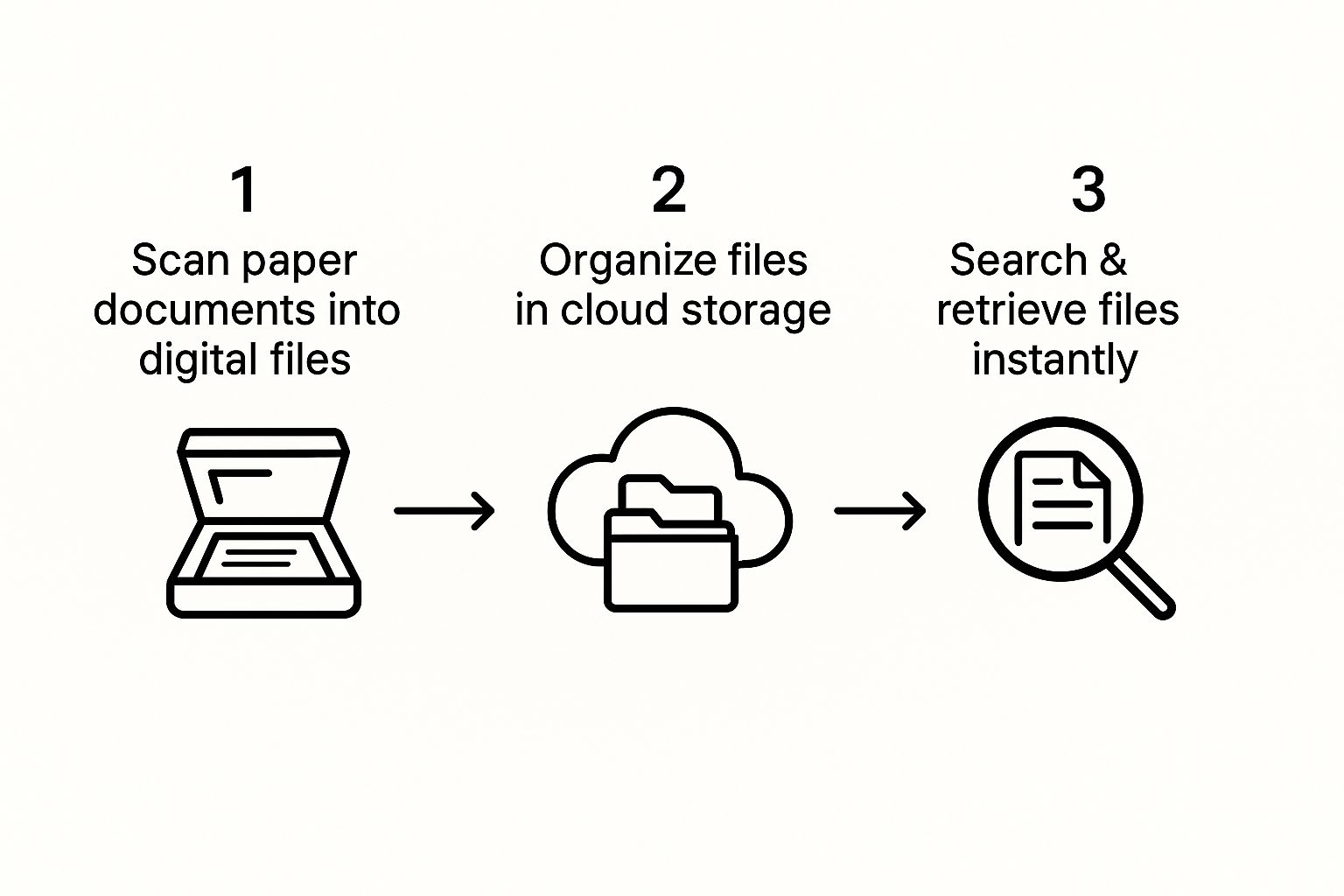When you hear "paperless office," it’s easy to think it's just about scanning documents and saving a few trees. But that’s only scratching the surface. The real shift is moving from clunky, physical paperwork to smart, digital workflows that completely change how your business operates. It’s less about swapping file cabinets for cloud folders and more about making your entire team more efficient, secure, and ultimately, more profitable.
Why Going Paperless Is a Smart Business Move

Let's be real—the "go green" angle is a great bonus, but it's not the primary reason businesses are ditching paper. The real motivation comes down to cold, hard business metrics. Old-school paper systems create a kind of organized chaos that quietly eats away at your time and money.
Think about a typical day at a growing company. Maybe you’re a mid-sized marketing agency juggling client contracts, dozens of vendor invoices, and endless creative briefs. How much time is wasted when someone can’t find the latest version of a proposal? Or when the finance team has to hunt down a manager for a signature on an urgent purchase order? These aren't just minor frustrations; they're direct hits to your bottom line.
The Hidden Costs of Sticking with Paper
The price of paper isn't just what you pay for the reams themselves. The true expense is buried in lost productivity. Every minute an employee spends digging through a filing cabinet or searching a cluttered shared drive for a specific document is a minute they aren't focused on what truly matters—serving clients or growing the business. Over a week, a month, or a year, that lost time adds up fast.
This reality is why the market for these solutions is booming. The paperless office system market was valued at USD 30.5 billion in 2024 and is projected to hit USD 62.4 billion by 2033. When you consider the average office worker churns through about 10,000 sheets of paper a year, you start to see the enormous potential for improvement.
A paperless system isn't just another piece of software; it's a fundamental shift in how information moves through your company. It retools your workflows for speed, accuracy, and instant access, turning your data from a frustrating liability into a powerful asset.
Ultimately, going paperless solves real-world business problems. It tightens up security, helps teams work together more effectively, and smooths out the processes that drive profitability.
How Daily Operations Change in a Paperless Office
The table below breaks down just how different day-to-day tasks become when you move away from paper. It’s a direct comparison that shows the business impact of modernizing your processes.
As you can see, the improvements are tangible and immediate. By embracing these changes, you’re also taking a meaningful step toward your environmental goals, making it a key part of broader sustainable office solutions. In the end, going paperless is less about the paper itself and more about building a business that’s resilient, agile, and ready for whatever comes next.
Auditing Your Current Paper Workflows

Before you even think about shopping for software, you need a clear picture of what you're trying to fix. The best paperless solutions aren't about tech for tech's sake; they're about solving real, frustrating problems. That means it’s time to conduct a "paper trail audit" to see exactly where—and why—your company is still leaning on physical documents.
Don’t worry, this isn’t some complex technical ordeal. It really just starts with conversations. Sit down with the people on the front lines in finance, HR, sales, and operations. Ask them what drives them crazy about the current paper processes. What takes forever? What always gets lost? Understanding these human pain points is the first, most crucial step.
Identifying Your Biggest Paper Problems
Your goal here is to find the documents causing the most damage. Let's be honest, not all paper is created equal. A printed weekly memo is a minor annoyance, but a slow-moving client onboarding packet or a lost vendor invoice can hit your bottom line and tarnish your reputation.
To get a handle on this, create a simple tracking sheet or spreadsheet. Spend a week or two just observing and noting the patterns. You don't need to count every single sheet of paper, but you should try to answer a few key questions:
- What documents get printed most often? (Think invoices, contracts, work orders.)
- How many physical copies are typically made of each?
- Where do these papers physically travel? (From the printer to a manager's desk for a signature, then to a filing cabinet, for example.)
- How long does it really take to get something approved or processed?
- Which documents are a nightmare to find later on?
This simple exercise will quickly shine a light on the high-impact areas where a paperless solution will give you the fastest and most meaningful results.
Mapping the Document Lifecycle
Once you’ve zeroed in on your problem documents, it's time to trace their journey. A document's lifecycle covers every single touchpoint, from the moment it’s created to when it’s finally archived or shredded.
Let's use a classic example: a new client contract.
In a paper-heavy office, its journey probably looks something like this:
- The sales manager drafts the contract from a template and hits "print."
- The printed copy is then walked over to the legal team for review and handwritten notes.
- The final version gets printed (again), stuffed in an envelope, and mailed to the client.
- The client signs and mails it back, a process that can easily eat up days, if not weeks.
- When it finally returns, someone makes copies for finance and legal, then files the original in a massive cabinet.
Every step is a potential delay, a chance for a document to get lost, or an opportunity for human error. By mapping this out, you get a clear blueprint of your current reality, highlighting every single friction point a digital tool could eliminate.
An honest audit is about more than just costs. It’s about measuring the time and energy your team loses to inefficient processes. Pinpointing these bottlenecks is essential for choosing a solution that truly solves your team's biggest headaches.
Quantifying the Real-World Impact
With your audit findings in hand, you can start attaching real numbers to the problem. This is how you shift the conversation from vague complaints like "invoice approvals take forever" to a solid business case: "Invoice approvals take an average of 7 business days and require 4 different people to handle the same piece of paper."
Here’s a simple way to frame the impact:
This kind of analysis builds a powerful argument for investing in paperless office solutions. You’re not just buying software; you’re solving specific, measurable problems that are holding your business back. With this clear roadmap, you're finally ready to evaluate tools that will make a genuine difference.
How to Choose the Right Paperless Solutions
Navigating the market for paperless tools can feel like walking into a massive, noisy hardware store without a shopping list. Every vendor claims their product is the ultimate fix, but I've learned from experience that the best solution is always the one that solves your specific problems. Now that you've got the insights from your paper trail audit, you can finally cut through the marketing hype and focus on what truly matters.
This isn't about just picking one piece of software; it's about building an ecosystem. You're looking for tools that talk to each other, creating a smooth, connected flow of information from one department to the next. The good news is that you have more options than ever. The global market for these tools is set to hit approximately 15 billion USD by 2025 and is projected to grow by 12% each year through 2033. That growth is fueled by businesses like yours demanding better efficiency.
Understanding the Core Tool Categories
Most paperless solutions fall into a few key categories. Once you understand them, you can start matching the right tool to the right problem you uncovered in your audit.
Document Management Systems (DMS): Think of this as your new digital filing cabinet. A DMS is a central, secure hub for all your files. A good one, like Nora, does more than just store documents—it gives you version control, access permissions, and a search function that actually works.
Optical Character Recognition (OCR) Software: This is the magic that makes your scanned documents searchable. OCR tech turns a picture of text (like a PDF scan) into actual text data. It’s what lets you find that one specific clause in a 50-page contract without having to read the whole thing.
E-Signature Platforms: Absolutely essential for any process involving approvals or contracts. These tools provide a legally-binding, secure, and fast way to get documents signed. They also create a verifiable audit trail that’s often more robust than a pen-and-paper signature.
Collaboration and Communication Hubs: This is where your team gets work done together. For a field service business, a tool like Nora uses a familiar platform—WhatsApp—to bridge the gap between technicians and the office. It turns quick voice notes or photos from the field into structured job logs automatically.
To see how these pieces fit together, take a look at this simple workflow.

This shows the fundamental journey from a physical piece of paper to instantly accessible digital information, which is the heart of any effective paperless system.
Your Practical Evaluation Checklist
When you start vetting specific products, it’s easy to get lost in a sea of features. Instead, I recommend focusing on these critical, real-world criteria. This simple checklist will help you tell if a solution is a true fit for your business or just another shiny object.
1. Does It Integrate Seamlessly?
A new tool should make your life easier, not create another island of data. Always check if the solution plays nice with the software you already depend on, like your accounting system (QuickBooks, Xero), CRM, or field management platform. A tool like Nora, for instance, is built to push data directly into these systems, which means no more mind-numbing manual entry.
2. Is It Genuinely User-Friendly?
Let's be honest: if a tool is a pain to use, your team won’t use it. The best solutions require minimal, if any, training. Look at Nora’s use of WhatsApp. Technicians don’t have to learn a new, clunky app; they just use a tool they already know and love. This is how you get adoption rates to skyrocket.
The best technology is invisible. A solution that meets your team where they already are—whether in their email inbox or a messaging app—will always outperform a complex system that forces them to change their habits.
3. Does It Meet Security and Compliance Needs?
This is completely non-negotiable, especially if you handle sensitive information. Dig into the security features. You're looking for things like data encryption, granular access controls, and proof of compliance with regulations like GDPR or HIPAA if they apply to your industry.
4. Can It Solve Your Top 3 Problems?
Go back to your audit notes. If your biggest headache is chasing down job notes from the field, a solution like Nora that automates that specific task is a perfect match. If invoice approvals are your main bottleneck, a DMS with automated workflows should be at the top of your list. Don't get distracted by a tool that solves problems you don't actually have.
As you narrow down your options, it helps to think about specific situations. For example, I’ve seen many businesses that still have to deal with faxes for legal or medical documents. As you go digital, you might need a bridge solution. In that case, you’ll want to compare online fax services to find a cost-effective alternative.
Ultimately, choosing the right paperless office solutions comes down to making deliberate, informed decisions that directly address your biggest operational pains and move you closer to your goals.
Rolling Out Your Paperless System Effectively

Alright, you've chosen your paperless solution. Now comes the critical part: getting it up and running without causing total chaos. Trust me, the "big bang" approach—flipping a switch and forcing everyone to change overnight—is a surefire way to get pushback and create a mess.
A much smarter, more human way to do this is with a phased rollout. You start small, prove the value, and let the success build its own momentum. This approach turns a potentially disruptive change into a collaborative and even exciting process.
And this isn't some niche trend; it's a massive shift in how businesses operate. The paperless system market was already valued at USD 2.22 billion in 2024 and is projected to hit USD 4.99 billion by 2033. That kind of growth tells you that countless companies are making this work. You can dig deeper into the paperless system market growth to see the stats and what’s fueling this move.
Start with a Pilot Program
Instead of trying to boil the ocean, pick one department to be your trailblazer. This pilot group gets to test-drive the new system, help you iron out any wrinkles, and become your first internal success story.
Who makes a good candidate? Think about teams that are either generally tech-savvy or are currently drowning in paper. Your sales team, for instance, is often a great pick. They’re mobile, need instant access to proposals and contracts on the go, and will immediately feel the benefit of digital tools. Or consider HR—a department buried in onboarding forms and employee files that could demonstrate massive efficiency gains.
The key is to choose a team that’s open-minded and has a manager who can champion the project. Their positive experience will be the best marketing you can get when it's time to roll it out to other departments.
Figure Out Your Data Migration Plan
Once your pilot team is ready, you need a plan for their documents. Don't fall into the classic trap of thinking you must scan every single piece of paper from the last decade. That’s a project-killer right there.
I always recommend a “day-forward” approach for the pilot. From a set launch date, all new documents are digital-first. This immediately stops the paper pile from growing and lets the team get comfortable with the new workflow without being buried by the backlog.
For all the old files, you have a few choices:
- Scan Immediately: These are the active, critical documents your team needs every day. For a sales team, this would be active client contracts or recent proposals.
- Scan on Demand: These are older files that you might need but don't look at often. Scan them as the need arises, which spreads the work out over time.
- Archive or Securely Destroy: These are documents past their legal retention period. Get them shredded securely and be done with them.
I’ve seen companies waste weeks digitizing ancient files that nobody ever looks at again. Don't make that mistake. Focus your energy on the documents that actually drive your business today.
Set Up Simple Digital Filing Rules
A digital system can get just as disorganized as a physical one if you don't have some ground rules. Before the pilot starts, sit down with the team and create a simple, intuitive digital filing structure.
With a platform like Nora, this could mean setting up clear tags for job types, client names, or project stages. The goal isn’t to create a rigid, complicated hierarchy. You just need enough consistency so everyone can find what they need, fast.
For example, you might agree on a simple naming convention for all contracts, like: ClientName - Contract - YYYY-MM-DD.
Your pilot program is the perfect testing ground to refine these rules. What looks good on paper might feel clunky in practice. Listen to your pilot users and be ready to adapt. These early adopters are your champions, and they'll help you perfect the system before you introduce it to the entire company.
Getting Your Team On Board and Tracking Your Wins
You can pick the absolute best technology on the market, but if your team doesn’t actually use it, it’s just expensive shelfware. This is the part where so many paperless projects stumble and fall—not because the software was wrong, but because the human side of the equation was completely overlooked.
Successfully getting your team to adopt new tools is really about managing change. It’s a culture shift, not just a software deployment. When people genuinely understand why you're making a change and, more importantly, how it makes their own day-to-day work less of a headache, they’ll actually want to use it.
Answer the "What's In It for Me?" Question
For every single person on your team, the most critical question you need to answer is, "What's in it for me?" Vague promises like "improved efficiency" mean nothing. You have to get specific and connect the new system directly to their biggest daily frustrations.
Think about it. Don't just tell your field techs that a tool like Nora will "improve communication." Show them. Explain how sending a quick voice note from their phone means they'll never again have to spend 15 minutes after a long, hard day trying to decipher their own chicken-scratch handwriting to fill out job reports.
Frame the benefits for each person's reality:
- For Field Technicians: "You can log all your job notes with a simple voice message in seconds, right from the site. No more end-of-day paperwork."
- For Office Administrators: "You'll get perfectly clear, organized job notes instantly. No more chasing down technicians for clarification before you can send an invoice."
- For Managers: "You can see real-time progress on any job without interrupting your team, which lets you spot issues before they blow up."
This kind of targeted communication transforms a top-down mandate into a personal upgrade for each employee.
Build an Internal Support System
Even with the most intuitive software, people will have questions. If you don't have a clear plan for support, you'll see frustration build and momentum grind to a halt. Don't leave everyone to fend for themselves—create a network of internal champions.
Your best champions are the folks from your pilot program who have already seen the benefits firsthand. They become the go-to experts for their peers, offering help that feels much more approachable than going to a manager. In fact, one study found that organizations with effective change management are six times more likely to meet their project objectives.
The goal isn't just to launch a tool; it's to foster a culture that values efficient, digital workflows. This happens when people feel supported, heard, and empowered by the new technology, not burdened by it.
A solid support system is a mix of people and resources. Think about setting up a dedicated chat channel for quick questions, creating short video tutorials for common tasks, and holding regular check-ins to see what’s working and what isn’t.
Measure What Actually Matters
To prove the value of going paperless, you need to move beyond gut feelings and look at the data. This isn't just about saving money on paper and ink; it’s about tracking real, tangible improvements in how your business operates. The key performance indicators (KPIs) you track should tie directly back to the problems you uncovered in your initial paper trail audit.
Here are a few powerful KPIs to start with:
These metrics do more than just justify the investment—they create a powerful feedback loop. When you can walk up to your team and show them that their efforts have cut invoice processing time in half, it reinforces the value of the change. It builds momentum and gets everyone excited for the next improvement, turning your paperless initiative into a clear, measurable success story.
Answering Your Questions About Going Paperless
Even with a solid plan, I get it—making the jump to a paperless office can feel daunting. It’s totally normal to have questions about the nitty-gritty details, from legal stuff to security. Let's walk through some of the most common concerns I hear from businesses making this switch.
"But What About Legal Documents and Signatures?"
This is often the first and biggest hurdle people bring up. Are digital documents and e-signatures really as legit as ink on paper? For the most part, the answer is a resounding yes.
Today's e-signature platforms are built to be legally binding for almost all business agreements around the world. These systems don't just capture a signature; they create a secure, verifiable audit trail. This log often gives you stronger proof of who signed, what they signed, and when they signed it than a simple wet signature ever could.
Still, it pays to be cautious. Some highly specialized documents, depending on your industry or location, might have unique rules.
A quick chat with your legal counsel is a small investment for massive peace of mind. Before going all-in, have them confirm your chosen e-signature process ticks all the compliance boxes for your specific contracts.
This simple check ensures your new digital workflow starts on a rock-solid, legally compliant foundation.
"How on Earth Do We Tackle This Mountain of Old Paper Files?"
Staring down a room full of filing cabinets is enough to make anyone want to give up. The trick is to not even think about scanning everything at once. A phased approach is your best friend here.
I always recommend starting with a "day-forward" scanning plan. It’s simple: from your official launch date, every new piece of paper that comes in gets scanned, and all new documents are digital from the start. This one move stops the paper pile from getting any bigger and lets your team get comfortable with the new system without the pressure of the backlog.
As for all those existing files, sort them into three piles:
- Scan Now: These are the active, critical documents your team needs day in and day out.
- Scan on Demand: Older files you might need someday, but aren't part of daily work. Just scan one if someone actually requests it.
- Archive or Shred: Any document that’s past its legal retention date. Get it out of your way for good (and securely!).
Honestly, many businesses find that bringing in a professional scanning service to clear the initial backlog is money well spent. It gets the job done fast and frees up your team to do what you actually pay them for.
"Is the Cloud Really a Secure Place for Our Documents?"
A perfectly valid question. But the truth is, a quality cloud-based document system offers security that a filing cabinet in an office can't even begin to match. It all comes down to choosing the right provider.
When you're vetting potential solutions, make sure these security features are standard, not expensive add-ons:
- End-to-end encryption that protects your files while they're being uploaded and while they're stored.
- Multi-factor authentication (MFA) to block anyone who isn't you from getting into your accounts.
- Granular access controls so you can decide exactly who sees what, down to the individual file.
- Compliance with major standards like SOC 2 or ISO 27001, which proves they take security seriously.
Think about it: a modern document management system is designed and tested by experts to fend off digital threats. A locked door just can't compete. By picking a platform with these features, you’re not just moving files online—you're giving them a serious security upgrade.
Ready to finally ditch the paperwork headaches and connect your field and office teams? See how Nora uses the simplicity of WhatsApp to automate job notes, saving you time and money.



